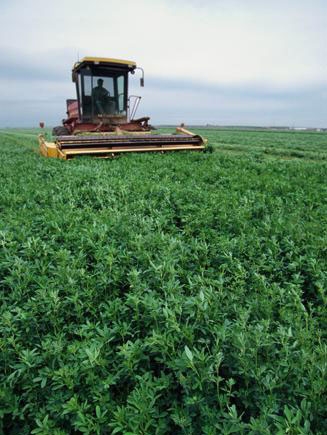Can GE and non-GE alfalfas co-exist?
Those of us who work with alfalfa have seen our much-loved Queen of Forages relegated to poster child of all things evil about genetic engineering (GE) and the supposed damage it may wreak. While hay growers have always felt alfalfa has received insufficient attention – this was probably not what they had in mind!
I’m referring, of course, to the release of Roundup Ready alfalfa (RRA) in 2005 and the subsequent lawsuit that stopped its planting from 2007 until 2011 – a case that went all the way to the Supreme Court!
The drama continues today with newly minted lawsuits, as farmers once again plant RRA and conventional alfalfa throughout the U.S. But what does this ballyhoo mean for those who actually grow alfalfa?
At the heart of the controversy is co-existence: whether cross-pollination from GE alfalfa would completely prevent organic or other growers who didn’t want GE alfalfa from practicing agriculture as they see fit. Or, alternatively, whether farmers can adopt methods to avoid undue neighbor influence or contamination.
Successful coexistence can be defined as the ability of diverse production systems (organic, GE-adopting, conventional) to thrive without excessive neighbor influence, or resorting to extraordinary protection measures.
Is co-existence possible? The answer is a definitive “yes” based on both history and principle. Agriculture is replete with examples of farmers adjusting and cooperating to make diverse systems work. In principle, there is no technical reason that diverse farming practices cannot co-exist.
So if you produce alfalfa for organic, export or other markets that don’t want GE crops, what is required? The answer is very different for those who grow alfalfa for hay vs. those who produce seed. Seed requires considerable isolation distances to prevent contamination – and always has.
For hay, a series of steps can reduce this risk to very low levels.
The first, and most important step is to plant seed tested and determined as non-GE. Plenty of conventional seed is available, as are inexpensive testing methods to assure that the seed is non-GE. Seed companies have committed to produce conventional seed in the future, including seed destined for GE-sensitive markets.
The next step is to assure that contamination doesn’t happen during harvest – through partial bales moving in balers from field to field or accidental misidentification of hay lots. This is likely the second-highest risk of contamination.
The lowest – but not zero – risk of contamination in hay: inadvertent gene flow from hayfield to hayfield.
Neighbors can reduce this risk further by: 1) Controlling unharvested plants on field edges and feral alfalfa along roadsides to prevent seed production; 2) Routinely harvesting hay to prevent excessive flowering; and 3) Completely removing crop before excessive flowering or seed production. Crop removal prevents permanent contamination, since seed must fall to the ground and grow into new plants to contaminate hayfields.
Lastly, it is important to understand thresholds or market tolerance.
Does a single RRA stem, accidently baled in a 200-ton lot of conventional hay (containing billions of stems), constitute contamination? This will be market-determined. Commercially available test strips will likely satisfy most if not all sensitive markets of a hay product’s non-GE status. All markets have thresholds for contaminants, and there is no reason to believe this to be an exception.
In short, methods are readily available to assure an alfalfa crop’s non-GE status, even as neighbors start growing GE alfalfa. These require a higher awareness of gene flow and other avenues of contamination, but do not appear to be onerous or difficult.
We also should not underestimate the importance of mutual respect and willingness to cooperate among parties as keys to a co-existence strategy. It is axiomatic that coexistence is impossible if parties are unwilling to listen to each other, allow a diversity of viewpoints or develop a way to resolve disputes.
The alfalfa industry has largely stepped forward to support diverse systems within the agricultural landscape and needs to continue to do so. This has been the case with National Alfalfa & Forage Alliance efforts to promote coexistence over the past 5 years, which continue today (see their website). Seed companies and growers continue to negotiate isolation distances for production of GE and non-GE seed. Likewise, hay farmers have demonstrated co-existence by growing RRA and organic alfalfa successfully on the same farms.
This year in California’s Imperial Valley, seed, hay and organic growers, exporters and seed companies have met extensively and decided to prohibit RRA in their region due to the close proximity of seed, hay, biological factors and the importance of seed and hay exports.
These are examples of “bottom-up” co-existence approaches led largely by farmers and companies – in contrast to regulations decided in Washington or through the courts.
The concept of right-to-farm and co-existence between neighbors and diverse industries is not new to agriculture. Yet the introduction of GE alfalfa and its potential influence on neighboring farmers requires improved co-existence strategies for alfalfa.
(This article was first printed in Hay and Forage Grower magazine.)

